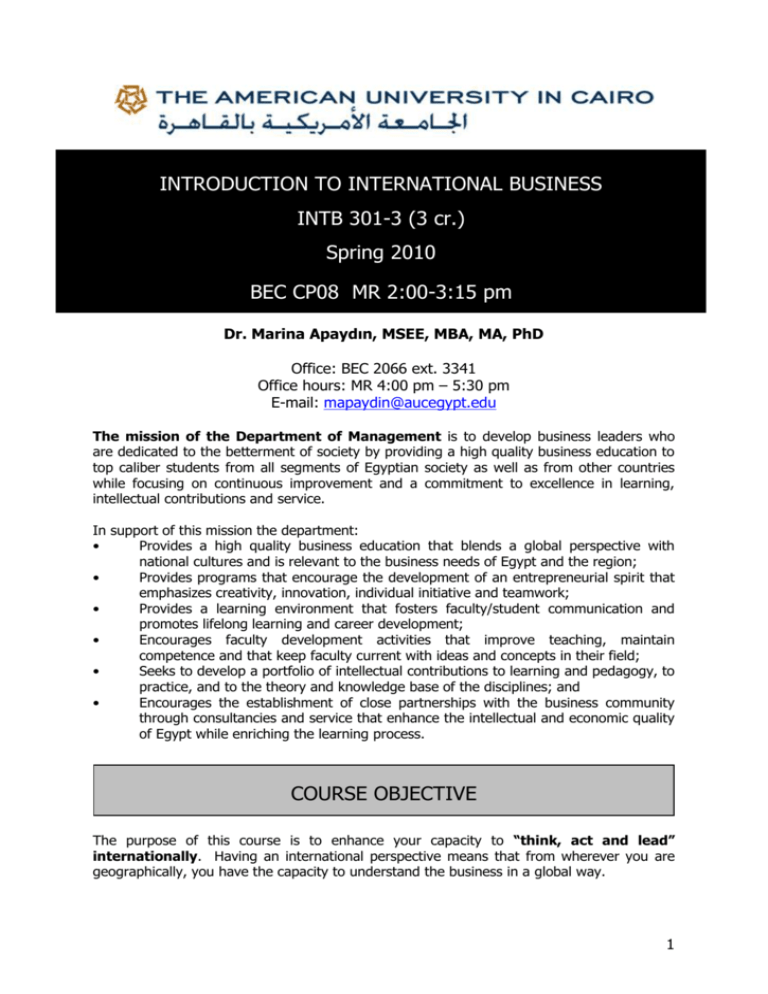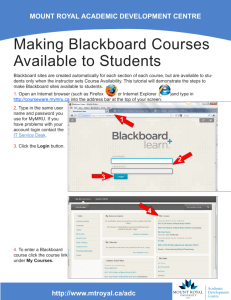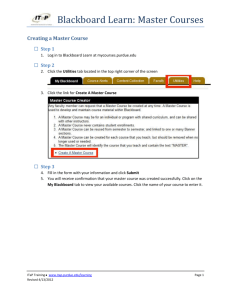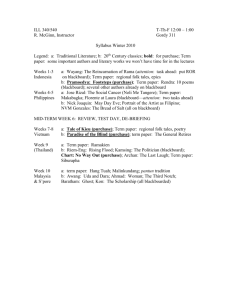COURSE OBJECTIVE INTRODUCTION TO INTERNATIONAL
advertisement

INTRODUCTION TO INTERNATIONAL BUSINESS INTB 301-3 (3 cr.) Spring 2010 BEC CP08 MR 2:00-3:15 pm Dr. Marina Apaydın, MSEE, MBA, MA, PhD Office: BEC 2066 ext. 3341 Office hours: MR 4:00 pm – 5:30 pm E-mail: mapaydin@aucegypt.edu The mission of the Department of Management is to develop business leaders who are dedicated to the betterment of society by providing a high quality business education to top caliber students from all segments of Egyptian society as well as from other countries while focusing on continuous improvement and a commitment to excellence in learning, intellectual contributions and service. In support of this mission the department: • Provides a high quality business education that blends a global perspective with national cultures and is relevant to the business needs of Egypt and the region; • Provides programs that encourage the development of an entrepreneurial spirit that emphasizes creativity, innovation, individual initiative and teamwork; • Provides a learning environment that fosters faculty/student communication and promotes lifelong learning and career development; • Encourages faculty development activities that improve teaching, maintain competence and that keep faculty current with ideas and concepts in their field; • Seeks to develop a portfolio of intellectual contributions to learning and pedagogy, to practice, and to the theory and knowledge base of the disciplines; and • Encourages the establishment of close partnerships with the business community through consultancies and service that enhance the intellectual and economic quality of Egypt while enriching the learning process. COURSE OBJECTIVE The purpose of this course is to enhance your capacity to “think, act and lead” internationally. Having an international perspective means that from wherever you are geographically, you have the capacity to understand the business in a global way. 1 LEARNING GOALS AND OUTCOMES The learning goals of the course can be divided into content and skill goals. By the end of the course a student is expected to achieve the following outcomes. Content 1. Each student will be able to assess the role of social, cultural, political, legal, and technological environment in aiding or hindering international business. 2. Each student will be able to understand the theoretical relationship underlying international business transactions and the integration of functional activities in international firms. 3. Each student will be able to identify important opportunities and challenges in the international environment and design strategies to deal effectively with them. 4. Each student should be able to lead and implement internationalization. Skills 1. Communication – each student will be able to communicate effectively in written and oral form. 2. Ethics - each student will be able to define and describe ethical issues, diversity and the need for socially responsible organizations. 3. Teamwork – each student will be able to effectively contribute to the teamwork, team member learning and group dynamics. 4. Critical thinking – each student will be able to critically evaluate business problem, issue, information obtained from media or internet, his/her own knowledge, progress and behavior. COURSE MATERIALS Textbook: Daniels, Radebaugh & Sullivan, “International Business: Environments and Operations,” 12th Edition, 2009. Optional manual: Louise A. Mauffette-Leenders, James A. Erskine, Michiel R. Leenders, "Learning with Cases", 3rd Edition, 2005 (on reserve). Each topic in the syllabus corresponds to a chapter in the textbook and will be covered in one or two classes. As a general rule, in the first class we will discuss the issues raised in the chapter using “Study questions” posted on the Blackboard and in the second class we will discuss the case and sometimes watch a video. The chapter assigned for the class (see class schedule on Blackboard) MUST be studied before the class in its entirety. “Studying” does not mean a casual reading. It means understanding the content and ability to answer the study questions posted on the Blackboard. 2 EVALUATION The grade for this course will be computed from the following factors (each item is described below in further detail): Evaluation factor Weight 1. Midterm 1 2. Midterm 2 3. Final Exam 15% 15% 15% 4. 5. 6. 7. 8. 5% makeup 5% 5% 15% 30% Case write up Blackboard activity Class attendance Class contribution Course project 1-3 MIDTERMS AND FINAL EXAM The midterms and final exam will consist of multiple choice tests (final exam will have essay questions as well) which will help assess your understanding of the theoretical concepts covered in the course. They will be administered individually during the class time on a „closed book‟ basis. 4. CASE WRITE UP The case “Globalization of international sports” (p. 3 of the textbook) is due February 8 by noon. The write up should be not more than one page single space, 12 pt. font, 1 inch margins all around. The case grade will be applied to improve the lowest of your 1-3 exam grades. 5. BLACKBOARD ACTIVITY Blackboard is an integral part of the course. All materials, assignments and announcements will be posted on the Blackboard. All class communication will be conducted via Blackboard. There will be no excuses allowed for not using the Blackboard. If you have any technical issue with Blackboard Help Desk in the Library should be able to help you. You must ensure your Blackboard is operational immediately and solve all the technical issues before the course starts. 6. CLASS ATTENDANCE Attendance will be taken sharply at the beginning of each class. If you must miss a session it is your responsibility to (1) advise me of your absence by email before the class and (2) arrange with your classmates for briefings, to pick-up hand-outs, etc. You should understand that frequent absence will seriously damage your class contribution grade. Missing more than 20% of the sessions may prevent you from writing the Final Exam. 3 The points for the attendance will be as following: 1 – present or a medical excuse with an advice before the class 0.5 – late or a medical excuse without an advice. 0 – absent without an excuse These points will be converted into a grade with 100% = number of actual classes. 7. CLASS CONTRIBUTION I will record class contributions immediately after each class. You may check your standing in this category anytime during the office hours. Since the richness of the classroom experience for all of us is heavily dependent on thorough preparation and high quality class contributions, a significant proportion of your grade will be based on the value of these contributions. Class contribution is more than the traditional class participation. Class participation requires you to be present and prepared for every session and share your views in the classroom discussion. I will feel free to call on any individual at any time. In general I evaluate contributions in an ascending order from good chip shots, to quite substantial comments, to case cracking contributions. I believe that challenge and debate are important to discovery and understanding, and I appreciate the willingness of individuals to engage in such activities with their classmates and with me. The class contribution grade is to recognize your contribution to the learning of your classmates. People will be called upon to participate, but it is safe to assume that waiting to be “cold-called” will not earn you a satisfactory participation grade. You will need to contribute voluntarily. At the same time, it is impossible for all students to participate in each class. In grading class contribution, I will be assessing the extent to which you have established a meaningful presence in the classroom, over the course of the semester, by making solid contributions on a regular basis. Class contribution has aspects of both quantity and quality. The following table illustrates the scoring scheme that I will use. Pts. 3 Category Excellent 2 Significant 1 Good -1 Poor Components of in-class contribution The comment adds substantial value to the discussion. Demonstrates willingness to take risks in attempting to answer difficult or unpopular questions. Breaks new ground and raises the flow of discussion to a higher level, often by synthesizing material and applying multiple lenses/techniques. The comment adds value to the discussion, beyond case facts. There is evidence of analysis rather than just the expression of opinion. Comments linked to those of others, facilitating the flow of the discussion. Demonstrates knowledge of readings and other relevant course material. Incorporate relevant insights from other courses or current affairs. The comment advances the flow of the discussion (including responses to questions from the instructor). Demonstrates clear grasp of case material. Information presented is relevant to the discussion CHATTING WITH NEIGHBORS. AUDIBLE OR VISIBLE CELL PHONES AND LAPTOPS. Lack of preparation for class discussion; failure to listen. Criticisms are directed at others versus towards their ideas. These points will be converted into a grade with 100% = maximum grade in the class. 4 5. COURSE PROJECT Information about the course project will be distributed separately. It will generally involve designing a comprehensive internationalization strategy for a local firm based on a thorough analysis of the environmental and business factors. Course project will be done in groups of no more than 4 people and will have several deliverables throughout the course. DEADLINES AND LENGTH LIMITS I appreciate the degree to which students want to be treated fairly and equitably when dealing with deadlines and length limits on assignments. If you are going to be late in submitting an assignment, you are expected to contact me by e-mail. Unless there is a compelling reason for missing the deadline, such as serious illness, lateness will result in a penalty in the grade for the project. A similar policy is in place for projects that exceed length limits. I expect that the document will be readable and tightly edited. Smaller font sizes than those specified and verbose analysis will not be viewed favorably. THE GRADE DISTRIBUTION A = score 90 and above A- = score between 87 and 89.5 B+ = score between 84 and 86.5 B = score between 80 and 83.5 B- = score between 77 and 79.5 C+ = score between 74 and 76.5 C = score between 70 and 73.5 C- = score between 67 and 69.5 D+= score between 64 and 66.5 D = score between 60 and 63.5 D- = score between 57 and 59.5 F = 55 or below EXPECTATIONS AND GROUND RULES You are expected to be fully engaged in the entire learning process. This means devoting time and energy to preparation before class, including learning team meetings, listening to others and engaging in class discussions. Collective reasoning and discovery are critical to the successful application of the case method. Here are straightforward ground rules that I would like us to follow. APPEAL OF GRADES Any appeal should be made within three days of receiving the grade, return the paper to me with a note summarizing your concerns. I will deliver a written reply after reviewing your comments. If you are not satisfied at this stage, we can then make an appointment to 5 discuss your paper and its grade. If a grade is appealed, the grade may be changed upward or downward. You can also request feedback on your ongoing class contribution grade. ACADEMIC INTEGRITY Valuing the concepts of academic integrity and independent effort, the American University in Cairo expects from its students the highest standards of scholarly conduct. The University community asserts that the reputation of the institution depends on the integrity of both faculty and students in their academic pursuits, and that it is their joint responsibility to promote an atmosphere conducive to such standards. Learning is enhanced through cooperation and as such you are encouraged to work in groups, ask for and give help freely in all appropriate settings. At the same time, as a matter of personal integrity, you should only represent your own work as yours. Any work that is submitted to be evaluated in this class should be an original piece of writing, presenting your ideas in your own words. Everything you borrow from books, articles, or web sites (including those in the syllabus) should be properly cited. Although you are encouraged to discuss your ideas with others (including your friends in the class), it is important that you do not share your writing (slides, MS Excel files, reports, etc.) with anyone. Using ideas, text and other intellectual property developed by someone else while claiming it is your original work is plagiarism. Copying from others or providing answers or information, written or oral, to others is cheating. Unauthorized help from another person or having someone else write one‟s paper or assignment is collusion. Cheating, plagiarism and collusion are serious offenses that could result in an F grade and disciplinary action. Please pay utmost attention to avoid such accusations. All required papers may be subject to submission for textual similarity review to the commercial plagiarism detection software Turnitin.com. CLASS BEHAVIOR Chatting with neighbors during the class will result in a negative contribution grade and eventual excuse from the class. Lateness to the class will impair your contribution grade for that class. Making noise while coming late may result in a negative participation grade for the session. No cell phones or laptops are allowed in the classroom. Sending or receiving a call or text message, or having an opened laptop will result in a negative contribution grade; Detailed note-taking during class can be distracting for others and counterproductive to your own learning. I advise you to be selective in taking notes during class. Instead, it is a good idea to consolidate what you have learned after the class. Thank you for your cooperation and enjoy the class! 6



